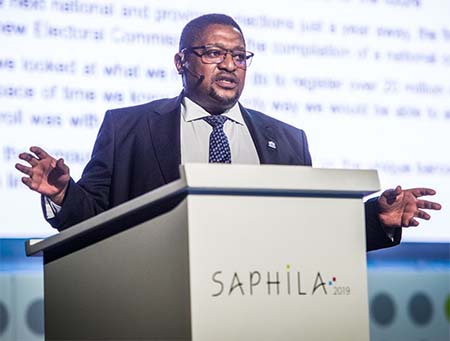Kathy Gibson is at Saphila in Sun City – The latest national and provincial election in South Africa went off reasonably smoothly and, as before, technology played a key role in its success.
Glen Mashinini, chairperson of the Independent Electoral Commission, points out that the IEC has held six national and provincial elections and five municipal elections as well as hundreds of by-elections over the last 25 years.
The fact that the elections are credible has allowed South Africa to escape some of the ramifications of contested election results, he points out.
He remembers the 1994 election, when there was no voters roll and six different identity documents – plus just four months to plan and execute.
These elections were delivered largely because of political will from the people of South Africa, he says.
But it was clear that a permanent, professional and technology-driven electoral management body was needed, able to design and implement world-class electoral processes and systems which would sustain free and fair elections for the future.
When the IEC looked at what was need to register more than 20-million eligible voters in a very short space of time, it introduced the zip-zap machines that could scan the barcode of ID books to accurately identify people, and build a voters roll.
Between 1999 and 2019, the voters roll grew by 47% from 18,17-million people to 26,7-million people.
At the same time the number of voting stations grew from 14 650 to 22 924.
In addition, the expansion of overseas voters was expanded to include all people living abroad. Categories of special votes were also introduced.
In addition, during this period the Constitutional Court ruled that voters must have addresses on the voters roll.
This has kept the IEC busy for the past two years, he adds.
“This is the end of the manual era,” Mashinini says.
The last elections brought forth a “perfect storm” of factors which threatened to undermine confidence and trust in the elections.
The issue of double voting exploded and by the end of voting day and the morning after, almost all of the media and political parties were questioning whether the elections could be trusted.
 “The question we had to ask was: how did this happen? There was nothing fundamentally different in the 2019 election process from previous elections.”
“The question we had to ask was: how did this happen? There was nothing fundamentally different in the 2019 election process from previous elections.”
Two main factors impacted on the controls of this election.
The first was Section 24A of the Electoral Act, which allowed voters to cast their ballots in voting stations where they are not registered.
“There are good reasons for this: for instance people who are disabled or bedridden, emergency personnel and others – we could not disenfranchise them since the cornerstone of our democracy is to give citizens their right to vote.
“What was not anticipated is the response from people,” Mashinini says. “People started shopping around for shorter queues, so what was meant to be a special facility become a convenience facility.
“When you can no longer predict demand, you run into shortages.”
The other issue was Home Affairs’ introduction of the smart ID card instead of the barcoded ID book. “With the ID book we can put a sticker to show the person has voted; with the smart ID this is not possible.”
The ink was also able to be removed. “Now the ink was meant for law-abiding citizens,” Mashinini points out. “The systems held, but the excitement on the side caused some confusion.”
The core of the issues facing the IEC in future is to ensure that it delivers on its mandate, with an eye to all stakeholders.
The non-negotiable deliverables are to conduct a free and fair election that has integrity and reliability, as well as trust, vitrification and transparency. the IEC has to retain the secrecy of the core so that it is credible and professional, and that it encourages voter participation with conducive conditions and accountability.
The stakeholders are voters, contestants and the public, as well as state, media, taxpayers and the general public. There is also a mix of domestic and international stakeholders, Mashinini points out.
The landscape is multidisciplinary, changing and complex. It is vigilant, with threats from paranoia and cyberattacks. And elections are high-stakes. “This is a high-stakes business and people are prepared to do anything to win,” Mashinini points out.
This means the leadership of the IEC has to be stable, innovative, consultative, team players and risk-takers, he adds.
The standards that have to be maintained when it comes to elections are efficiency; that they are lawful and compliant; and that there is a peaceful transition that is affordable and timely, with complete transparency.
The IEC enterprise has to balance the electoral values that consist of the electoral timetable, ERP and project management logistics, voters roll, balloting, counting audit, results transmission, results consolidation and transmission, and the candidates list, as well as seats allocated.
Budgeted resources are human people and skills, rules and processes, enterprise systems and procedures, and physical and digital infrastructure and technologies.
A quantum leap in the use of technology took place between the 1994 elections and 2019; and Mashinini believes we need to take another quantum leap into the next era of technology for the next 25 years.
“I believe technology is the only thing capable of addressing the risks and opportunities,” he says.
The IEC has made no firm decision on the future use of technology. However, it believes these must be anchored in sustainability, and that business imperatives must be at the heart of safeguarding the electoral democracy.
Among the risks and challenges are cybersecurity threats and the costs associated with technology investment.
Technology is not the silver bullet, Mashinini says, but it offers the greatest promise for overcoming the IEC’s challenges.
